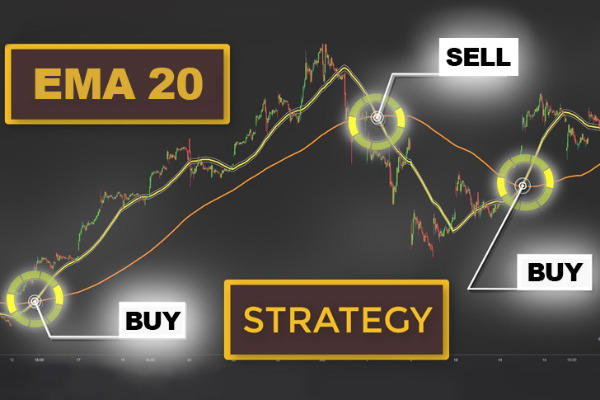There are many ways to close a trading position, like manual closing, stop loss and take profit, as well as trailing stop. How to do each?
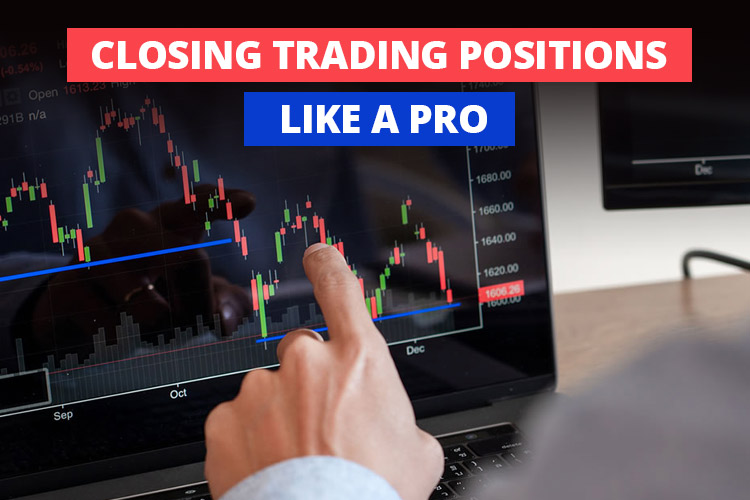
Closing a trading position is exiting a trade and realizing your profits or losses. It is an important part of trading, as it allows you to protect your profits, limit your losses, and improve your trading results. There are many different ways to close trading positions, and the best way for you will depend on your trading style, risk tolerance, and the specific circumstances of the trade.
Here are four of the best ways to close trading positions:
- Manual closing
- Take profit orders
- Stop loss orders
- Trailing stop orders
Mastering the art of closing positions can significantly impact your trading success. So, let's dive into these four strategies and enhance your trading prowess.
1. Manual Closing
Manually closing a forex trade is the simplest way to exit a position. The trader monitors the market and manually closes the trade when they believe it is time to take profits or cut losses.
For example, if a trader has a long position in EUR/USD and believes the price will decline, they can manually close the trade by selling the euro and buying the US dollar.
Closing a trade requires discipline, patience, and experience. Traders must analyze the market and decide when to exit a position. This can be challenging, especially in volatile markets.
There are several reasons why manual closing is considered the best way to close a position in forex trading:
- Gives you more control: When you manually close a position, you have complete control over the timing and price of the exit. This is not always possible with automated trading strategies.
- Allows you to react to market changes: If the market moves in your favor after you open a position, you may want to close the position to lock in profits manually. Conversely, if the market moves against you after you open a position, you may want to close the position to limit losses manually. Automated trading strategies may not be able to react to market changes as best as you can.
- Help you avoid slippage: Slippage is the difference between the expected price of a trade and the actual price at which the trade is executed. It can occur due to market volatility or liquidity issues. Manual closing can help you avoid slippage by allowing you to set a specific price for the exit.
Of course, manual closing has some potential drawbacks. For example, it can be more time-consuming and require more attention than automated trading strategies. Additionally, if you are not experienced in trading, you may make mistakes when manually closing positions.
As a matter of fact, manual closing is preferred by experienced traders who want more control over their trades. It's usually optimized using technical indicators, one of which is the Simple Moving Average. In this example, traders can use the combination of SMA 50 and SMA 200.
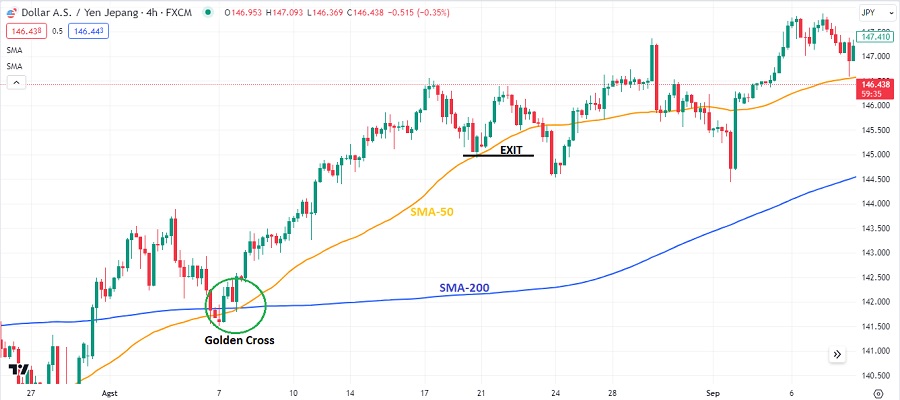
The chart above shows a golden cross signal, where the SMA 50 successfully crosses the SMA 100, indicating a bullish signal. Manual closing of a buy position can occur when the chart experiences a pullback and touches the SMA 50 line.
Apart from the Moving Average, many other indicators can be used to exit positions manually, such as Fibonacci retracements, volatility indicators, support and resistance levels, etc.
2. Take Profit Orders
Take profit orders are a type of order that automatically closes a trade when the market reaches a predetermined profit level. This is considered one of the best ways to close trading positions since it helps traders lock in their profits and avoid the temptation to close a trade too early or too late.
For example, if a trader buys EUR/USD at 1.2000 and sets a take profit order at 1.2050, the trade will close automatically when the market reaches 1.2050. This ensures that the trader makes a profit of 50 pips even when they're not actively checking their positions.
Take profit orders are typically used with stop loss orders to ensure traders have favorable risk/reward ratios. As with manual closing, using take profit will also be greatly assisted if traders use additional tools as locations for placing take profit orders, for example, support and resistance levels.
To use support and resistance levels to place Take Profit orders, traders need to pay attention to the following important things:
- If a trader opens a Buy position, Take Profit can be placed at the resistance level.
- Conversely, if the position is Sell, Take Profit can be placed at the support level.
For more details, please see the example below.
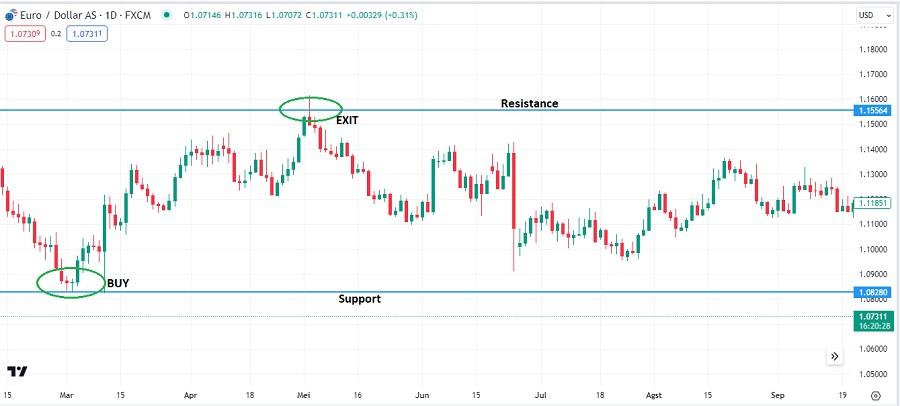
3. Stop Loss Orders
Stop loss orders are a type of order that automatically closes a trade when the market reaches a predetermined loss level.
You buy EUR/USD at 1.1000 and set a stop loss order at 1.0950. This means that if the price of EUR/USD falls to 1.0950, your order will be automatically executed, and your EUR/USD will be sold. This would save you from bigger losses if the price of EUR/USD eventually falls to 1.0940 or more.
Stop loss orders are a critical risk management tool for traders. They can help traders avoid losing more money than they can afford. There are several reasons why stop loss orders are considered one of the best ways to close positions:
- Help traders avoid large losses: If the market moves against a trader, stop loss can help them limit their losses to the amount they have set. This can be important for traders who cannot monitor the market closely or do not want to risk losing more money than they can afford.
- Make traders stay disciplined: Stop loss orders can help traders stay disciplined and avoid the temptation to hold on to losing positions in the hope that the market will turn around. This can be important for traders who are prone to emotional trading.
- Automate their trading: Stop loss orders can be automated, so traders do not have to close their positions manually. This can save time and effort.
However, it is important to note that stop loss orders are not always guaranteed to be executed. In volatile markets, the price may move past the stop loss level before the order can be executed.
To use stop loss orders efficiently, traders can also use the help of technical indicators. In this case, pivot points can be used as a reference. The previous pivot level is often regarded as a strong support or resistance level, so the price is less likely to break through this level. For more details, please see the chart below.
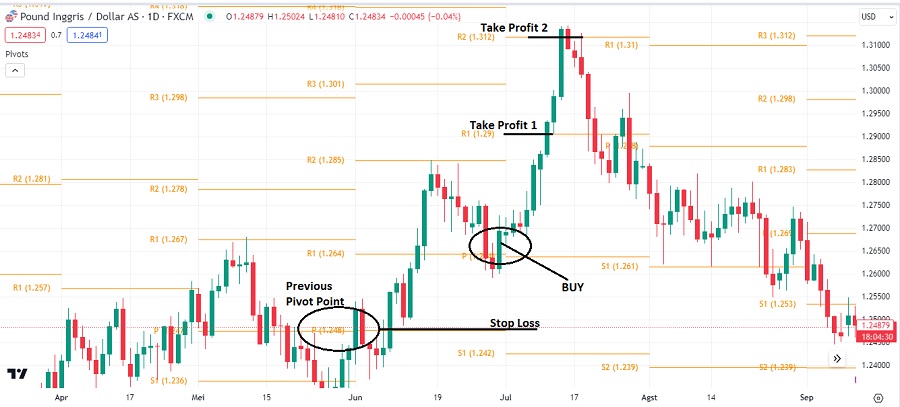
The exact level at which you place your stop loss order will depend on your risk tolerance and trading strategy. However, using the previous pivot level as a stop loss order is a good way to minimize risk based on the most recent market condition.
4. Trailing Stop Orders
Trailing stop orders are a type of stop loss order that automatically moves with the market as it moves in your favor.
For example, a trader opens Buy position on the EUR/USD pair at 1.2000 and set a trailing stop with a distance of 20 pips (0.0020 in terms of exchange rate). As the market moves in their favor, the trailing stop will adjust accordingly.
If the EUR/USD exchange rate rises to 1.2020, the trailing stop becomes active at 1.2000. It will keep locking in profits by that distance, so a rise to 1.2050 would trail the stop at 1.2030.
If the market reverses, the trailing stop remains fixed at its last set level.
Trailing stops can help you stay disciplined and avoid the temptation to close a winning position too early or hold on too long to a losing position.
A trailing stop is also useful for traders who want to protect their profits before the market reverses too far.
Things to Consider Before Closing Position
Before closing a forex trading position, there are several essential rules and considerations to keep in mind:
- Trading plan: When closing a position, refer to your trading plan to ensure you make the best decision. A good trading plan should include risk tolerance, profit targets, and stop loss levels.
- The current market conditions: If the market is volatile, you may want to close your position sooner rather than later to avoid losses.
- Technical analysis: If your technical analysis indicates the trend is reversing, you may want to close your position to avoid losses.
- Risk tolerance: How much risk are you willing to take on? If you are a risk-averse trader, you may want to close your positions sooner rather than later to avoid losses.
- Trading experience: How much trading experience do you have? As a beginner, you may want to close your positions more frequently than experienced traders.
Conclusion
Closing a trading position is an important decision that all traders must make. The best way to close a position depends on the trading style, preferences, and market conditions. However, some general rules can help you decide when and how to close your positions best. These rules include manual closing, take profit orders, stop loss orders, and trailing stops. By following these rules, you can minimize risk and maximize profits.

 Dedicated FREE FOREX VPS
Dedicated FREE FOREX VPS Free FOREX Virtual Private Server
Free FOREX Virtual Private Server MT4 Demo Contest, Get $500
MT4 Demo Contest, Get $500 Sign Up for an Account, Claim 60% Deposit Bonus
Sign Up for an Account, Claim 60% Deposit Bonus Free MT4/MT5 VPS 2024
Free MT4/MT5 VPS 2024 Send E-mail and Get Free Merchandise
Send E-mail and Get Free Merchandise $1K Refer a Friend Bonus for Pepperstone Pro clients
$1K Refer a Friend Bonus for Pepperstone Pro clients Maximize Your Earnings with 100% Deposit bonus
Maximize Your Earnings with 100% Deposit bonus Trade to Win, $5,000 Monthly Demo Contest
Trade to Win, $5,000 Monthly Demo Contest Claim 30% + 15% Deposit Bonus from LiteFinance
Claim 30% + 15% Deposit Bonus from LiteFinance





